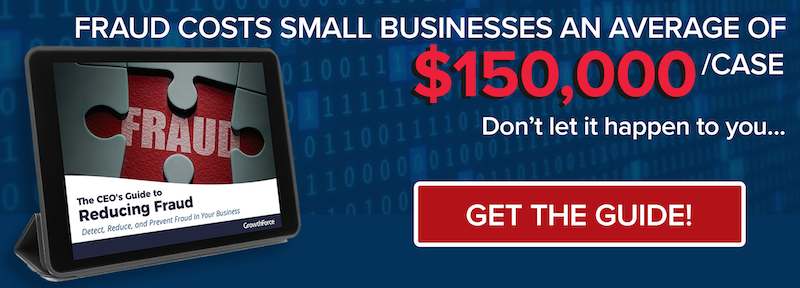2 min read
Every two years the Association of Certified Fraud Examiners (ACFE) releases the Report to the Nations on Occupational Fraud and Abuse. This report investigated business fraud from 114 countries and provided insight into occupational fraud at an international level. Let’s take a look at the ACFE’s most recent findings...
|
Key Takeaways
|
Here are some of the AFCE’s key figures and findings from the 2020 report:
- $125,000 – the median loss due to business fraud.
- 14 months – how many months on average went by before the fraud was detected.
- 66% - The majority of frauds committed were committed by individuals from one of six departments (accounting, operations, sales, management, purchasing, and customer service).
How Fraud Affects Small Businesses
When small businesses are hit by fraudulent activity, they cannot rebound as quickly as a large corporation can. For a small business that operates on a $700,000 annual budget, a loss of $125,000 can take a long time for the company to recover, versus say an enterprise with a $2 billion operating budget. In fact, the study found that almost half (54%) of all victim organizations don’t recover any of the losses due to fraud.
The study found that on average, businesses lost $125,000 due to fraud. The ACFE also found that of all of the companies included in the study, more than (21%) of the organizations reported losses of at least $1 million. A significant loss coupled with an extended period of time during which the fraud took place can be detrimental to a small business. A small organization that has continually lost thousands of dollars for a period of a year or more, sometimes is not equipped to rebound and will either have to downsize or close all together.
Steps to Take to Reduce Fraud
The smallest organizations that were looked at in the ACFE study had the largest median losses. This is because the smaller organizations on average don’t employ the same anti-fraud measures that larger organizations do. Fraud committed by higher-level employees was found to be significantly higher than by lower-level employees. For example, losses caused by managers totaled on average $160,000 whereas employee fraud had an average loss of $60,000. Implementing internal controls is one of the best steps to take to reduce occupational fraud.
Making sure that there isn’t just one single person responsible for accounts receivable and accounts payable drastically reduces the risk of business fraud. When you separate the duties among multiple employees, it is easier to track to see if there are any discrepancies in the figures. Besides dividing responsibilities among employees, there are digital tools you can leverage to prevent fraud as well. For instance, limiting access by role within QuickBooks allows only specific personnel to have access rights within the program. Implementing effective fraud detection also means being aware of things like chargeback fraud, committed against companies by customers. Both internal and external threats have to be on your radar for this reason.
For a growing number of small organizations, their system of fraud detection and prevention involves outsourcing their bookkeeping. Outsourcing not only allows the books to be monitored by a third party to monitor any suspicious activity but hiring an outsourced bookkeeping firm provides small businesses with an entire financial team – without the added burden and expense of building an in-house team.






